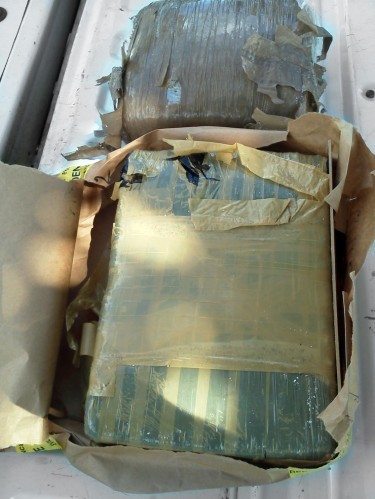
INDIAN RIVER COUNTY — Tightly wrapped packages of marijuana are washing up on barrier island beaches, including three that combined weighed more than 50 pounds, and the Coast Guard says a tough new U.S. interdiction program in the Caribbean may be forcing smugglers to dump their loads.
That increased surveillance is prompting drug smugglers to toss marijuana loads in the sea, including more than 400 pounds that washed up in Jupiter on Saturday.
On Sept. 16, Joseph Scarola’s eyes were peeled as he moved down the beach on his ATV to monitor sea turtles. He had just received a text message from a co-worker at Ecological Associates that she had found marijuana washed up on the island.
Scarola noticed a water-logged 10- by 12- by 5-inch bundle being lapped by the foamy surf.
A corner of the plastic and heavily taped bundle had been torn and the pungent smell of marijuana filled the area around him about a half a mile north of Golden Sands Beach.
“It was really strong,” Scarola said of the odor.
The package was the second bale of marijuana to wash ashore in northern Indian River County on the morning of Sept. 16.
Scarola’s coworker from West Palm Beach who had been filling in for another turtle monitor in Indian River County called police when she discovered a slightly smaller bundle around the John’s Island Club an hour earlier.
Ten days later, another turtle watcher found 33 pounds off South Beach.
The 58 pounds of marijuana, which authorities estimate could sell for $145,000 on the street, was turned over to the Indian River County Sheriff’s Office.
While a large find, the three bales pale in comparison to the 411 pounds of marijuana in eight burlap bags that washed ashore Saturday in Jupiter.
Depending on the grade, a pound of marijuana can range from $1,000 a pound to close to $5,000, authorities say. An in-between figure places the street value amount of the marijuana found in Indian River and Palm Beach counties at $1,172,000.
“That’s quite a bit of marijuana,” said Jupiter police Sgt. Scott Pascarella. He said a fisherman found the eight bundles. Police searched the waters for more but failed to find any.
Pascarella said he was grateful the fisherman called police.
The 27-year-old Scarola said he didn’t think for a second about not calling local law enforcement after he found the package.
That’s good news to Deputy Jeff Luther, the public information officer at the Indian River County Sheriff’s Office.
“It’s very dangerous and people may not know what they are messing with,” he said. “One way or another, trouble will follow if you decided to take it with you.”
The sheriff’s office stepped up its efforts to find bales of marijuana before beach walkers do, Luther said. Normally, the helicopters patrol for errant boats, but these days it’s been for marijuana.
The finds are reminiscent of the 1970s and 1980s when water-logged bales of marijuana dubbed “Square Grouper” dotted the state’s southern coastline.
There was hardly a morning when Indian River County didn’t have drugs come ashore on its 24 miles of coastline during that time period.
“You couldn’t watch it enough,” said Luther.
The areas’ recent finds appear to be a result of a massive U.S.–led, multi-agency, multi-country, drug seizure operation dubbed Operation Martillo – “hammer” in Spanish – that started in January.
Military helicopters and boats have been chasing smugglers’ boats and – in some cases submarines – to stop the open sea drug trade along the Central American isthmus.
In August, some 200 Marines landed in Guatemala to join the fight to rein in narco-terrorists. Not since the US troops pulled out of Guatemala in the middle of its civil war has there been such a large US presence there.
The Key West-based Joint Interagency Task Force -South, a component of U.S. Southern Command is heading the U.S. military participation.
The Coast Guard had seized 57 vessels and detained 301 people since the start of the operation through the end of July. The effort seized 78,672 pounds of marijuana and 139,799 pounds of cocaine.
Officials say that about 80 to 90 percent of all cocaine in the US passes through Central America.
El Heraldo, a Colombian newspaper reported recently that the operation through August was responsible for inflicting a loss of $2.12 billion on the drug trafficking networks.
That’s just what authorities know about and not what has been washing ashore in the recent weeks.
Drug runners typically throw the bundles overboard when being tailed and the Gulf Stream does the rest, pushing the bales north.
That’s how the pot likely ended up along South Florida’s coastline, said Coast Guard Chief Petty Officer Ryan Doss. “It’s pretty common when we are chasing drug smugglers,” he said.
Published reports on the operation say that on Aug. 2, the USS Underwood, a guided-missile frigate, recovered 2,700 pounds of narcotics from the Caribbean after a fast boat it was pursuing dumped its stash before drug agents could board it.
Doss said during the current anti-drug operation some sea chases have stretched for up to 100 miles.
Drug trafficking networks have been quick to adapt to the sea and air chases and have recently been using commercial fisherman to move their drugs, officials say.
Doss said the Coast Guard is ready for them.
“We are prepared for anything,” he said. “We check as many vessels as we can.”



